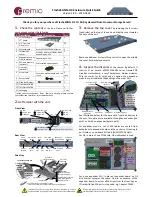
Rev. 1.00
96
September 11, 2018
Rev. 1.00
97
September 11, 2018
HT45F4050
A/D NFC Flash MCU
HT45F4050
A/D NFC Flash MCU
Counter Value
0xFFFF
CCRP
CCRA
STON
STPAU
STPOL
CCRP Int.
flag STMPF
CCRA Int.
flag STMAF
STM O/P Pin
Time
CCRA=0
CCRA = 0
Counter overflow
CCRA > 0 Counter cleared by CCRA value
Pause
Resume
Stop
Counter Restart
STCCLR = 1; STM [1:0] = 00
Output pin set
to initial Level
Low if STOC=0
Output Toggle
with STMAF flag
Note STIO [1:0] = 10
Active High Output select
Here STIO [1:0] = 11
Toggle Output select
Output not affected by
STMAF flag. Remains High
until reset by STON bit
Output Pin
Reset to Initial value
Output controlled by
other pin-shared function
Output Inverts
when STPOL is high
STMPF not
generated
No STMAF flag
generated on
CCRA overflow
Output
does not
change
Compare Match Output Mode – STCCLR=1
Note: 1. With
S
TCCLR=1, a Comparator A match will clear the counter
2. The
S
TM output pin is controlled only by the
S
TMAF flag
3. The output pin is reset to its initial state by a
S
TON bit rising edge
4. The
S
TMPF flag is not generated when
S
TCCLR=1
















































